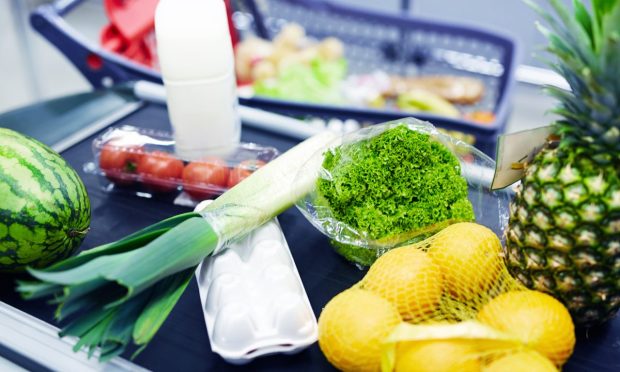5 Ways Grocery Checkout Changed in 2021

In 2020, grocery shoppers adopted self-checkout more than ever before, motivated by contagion concerns prompting them to avoid face-to-face contact and seek out quicker ways to move through crowded stores. In 2021, this shift presented grocers with the opportunity to rethink their checkout options for the more self-service-dependent future, spurred on by labor challenges that turned these channels from simply a benefit to an absolute necessity.
Sure enough, grocers rose to the occasion, with scan-and-pay solutions, smart carts and “Just Walk Out”-style frictionless checkout gaining steam.
Own-Device Payments Took Hold
For instance, midway through the year, Walmart announced that its membership-only warehouse club chain Sam’s Club saw a 43.5% year-over-year increase in the adoption rate of its Scan & Go own-device checkout feature, with 90% of those who try the feature using it again.
“I believe these things will always follow the path of least resistance for the member,” Tim Simmons, senior vice president and chief product officer at Sam’s Club, told Karen Webster in an interview. “So, if it’s simpler for a member to take out a phone, scan QR codes and check out, I think that’s the future of it.”
Related: Sam’s Club Touts 90 Pct Re-Use Rate For Its Touchless Checkout And Delivery Tech
The Carts Got Smarter
In November, meanwhile, it was reported that Albertsons Companies, the Boise, Idaho-based grocery giant that encompasses more than 20 popular supermarket chains across 34 states, is trying out smart carts at a Safeway location in Pleasanton, California and at an Albertsons in Eagle, Idaho. Moreover, in October, Instacart acquired Caper, the company powering Albertsons competitor Kroger’s “KroGo” smart cart test.
Read more: Grocers Try Smart Carts to Reduce Labor Costs, Shift Checkout to Consumers
Friction Points Were Eliminated
Additionally, where once technologies that allowed consumers to grab their item and walk out without stopping at any checkout station were fringe new experiments, these computer vision and sensor-enabled systems are gaining traction. Amazon is integrating its Just Walk Out technology into increasingly large stores, convenience store giant Circle K is testing out frictionless checkout, and U.K. grocers Sainsbury’s and Tesco are doing the same, as is Germany-based global discount grocery chain Aldi.
See also: Frictionless Checkout Goes Big with Amazon, Circle K
Frictionless Checkout Brings eCommerce Convenience into Stores to Drive Conversion
All of these tech-enabled self-checkout methods, especially the Just Walk Out-style options, reduce friction where consumers want those reductions the most. The PYMNTS study, Today’s Self-Service Shopping Journey: The New Retail Expectation, created in collaboration with Toshiba, which surveyed over 2,000 U.S. consumers about their shopping behaviors, found that 68% of grocery shoppers utilizing self-service checkout report doing so because they believe it is faster than traditional checkout, and 51% are motivated in part by a desire to skip the traditional checkout line.
More details: Consumers Want Self-Service Checkout Options But Rarely Get to Use Them
Adoption Grew, But Old Habits Proved Hard to Break
For all these developments, the study found that many consumers have not yet had sufficient motivation to depart from their familiar routines. The most popular reason that grocery shoppers listed for using manned checkout is that they regularly use this traditional option. Additionally, 35% actually reported that, at their grocery store, traditional checkout is the quicker choice.
Demand for Digital Wallet Payments Surged
In a matter of months, digital wallets became a must-have at checkout for millennials. Whereas
PYMNTS’ November 2020 Omnichannel Grocery Report, created in collaboration with ACI Worldwide, found that just 12% of millennials were “very” or “extremely” interested in using digital wallets to pay for their grocery purchases, that share soared to 50% as of PYMNTS and ACI’s August 2021 What Consumers Expect From Their Grocery Shopping Experiences report. Additionally, for bridge millennials, the share jumped from 12% to 48%, and for gen Zers from 6% to 44%.
You may also like: Digital Features Can Help Grocers Win Over 43 Percent Of Shoppers